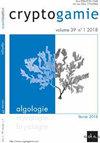IF 1.5
4区 生物学
Q3 MARINE & FRESHWATER BIOLOGY
引用次数: 11
摘要
摘要根据光镜和扫描电镜的观察,描述了两种新的硅藻种:A. laosica sp. nov.和A. genkalii sp. nov.。这些物种是在老挝发现的,这是该属首次在东南亚发现。该属的几乎所有种都在全北极被描述和存在。许多物种的分布范围有限,从化石沉积物、北美、蒙古或贝加尔湖、普雷斯帕湖和奥赫里德湖等古湖泊的当地特有地区已知。在这些古湖泊中发现的Aneumastus物种多样性高于全北极地区水体的总和。本属的少数报告来自南半球(如澳大利亚的新喀里多尼亚,非洲的坦噶尼喀湖),但这些分类群记录仅来自每个地区的单一阀,需要进一步的分类学调查和验证才能了解该属的全部分布范围。本文章由计算机程序翻译,如有差异,请以英文原文为准。
Aneumastus laosica sp. nov. and A. genkalii sp. nov. — Two New Diatom Species from Laos (Southeast Asia) with Comments on the Biogeography of the Genus
Abstract
Two new diatom species of the genus Aneumastus are described, A. laosica sp. nov. and A. genkalii sp. nov., based on light and scanning electron microscope observations. These species were found in Laos, and this is first finding of this genus from Southeast Asia. Almost all species from this genus were described and exist in Holarctic. Many species have restricted distributions and are known from fossil deposits, North America, Mongolia or local endemics of ancient lakes such as Baikal, Prespa and Ohrid. Diversity of Aneumastus species from these ancient lakes is higher than from waterbodies of the Holarctic region taken together. A few reports of this genus are from the southern Hemisphere (e.g. New Caledonia, Australia, Lake Tanganyika in Africa), but these taxon records are represented by a single valve only from every region and they require additional taxonomical investigation and verification to understand the full extent of the distribution of the genus.
求助全文
通过发布文献求助,成功后即可免费获取论文全文。
去求助
来源期刊

Cryptogamie Algologie
生物-海洋与淡水生物学
CiteScore
2.60
自引率
7.70%
发文量
11
审稿时长
>12 weeks
期刊介绍:
Cryptogamie is a fast-track and peer-reviewed journal of international scope publishing in English only. It accepts original papers and review articles on the taxonomy, biology and ecology of all cryptogams. An issue of Cryptogamie may be devoted to a single topic, under the responsibility of guest editor(s). All articles published in Cryptogamie are compliant with the different nomenclatural codes. A copyright assignment will be signed by the authors before publication.
Cryptogamie, Algologie accepts articles on systematics as well as ecology and evolution of any kind of algae (including Cyanobacteria).
 求助内容:
求助内容: 应助结果提醒方式:
应助结果提醒方式:


